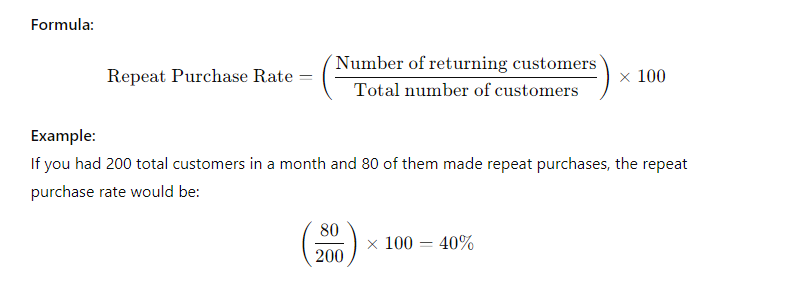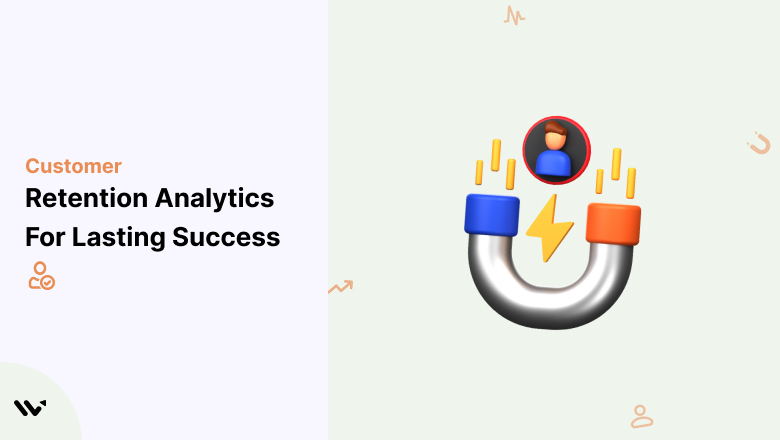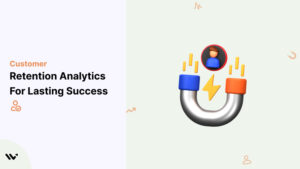Keeping customers happy and engaged isn’t just about offering great products anymore—it’s about knowing why they stay and what makes them leave.
Brands that thrive are those that are focused on customer retention analytics.
This sauce helps you better understand your customers, spot trends, and take action before they consider going elsewhere.
This blog will explore customer retention, its importance, and how to measure and improve it.
So, let’s begin this journey to becoming a customer retention champion!

What Exactly Is Customer Retention?
Customer retention analyzes customer data and behavior to determine why customers stay or leave a business. By examining past trends and patterns, you can predict future customer behavior, identify what causes churn, and implement strategies to retain customers.
This means tracking customer behavior using metrics like purchase history, engagement, and customer support interactions to find insights that drive loyalty to customers churn and reduce churn.
Why is Customer Retention Analytics Important?
Customer retention analytics is essential because it helps you understand why customers stay and why they leave, giving you the tools to act proactively. Here’s why it matters:
- Spot Churn Risks Early: Analytics reveals early signs of customer dissatisfaction, allowing you to intervene before they leave.
- Increase Customer Lifetime Value (CLV): By identifying behaviors that lead to loyalty, you can focus efforts on increasing long-term customer value.
- Personalize Experiences: Use data to tailor offers and communication, making customers feel valued and improving engagement.
- Improve Marketing ROI: Analytics helps you focus on the campaigns and channels that drive the most loyal customers, optimizing your resources.
- Boost Profitability: Retaining customers is cheaper than acquiring new ones. Loyal customers also buy more and refer others, driving revenue.
- Understand Customer Sentiment: Analytics shows you how customers feel, helping you refine your product or service to meet their needs.
Retention analytics gives you the power to keep customers engaged, satisfied, and loyal—essential for long-term growth.
Types of Customer Retention Analytics
Customer retention analytics can be divided into several types, each providing insights into existing customer behavior and new ones to analyze customer retention and loyalty.
1. Periodic Customer Retention
This cohort analysis involves tracking customer activity within a specific customer cohort over set periods (e.g., days, weeks, months). Calculating the percentage of active customers in each cohort retention analysis period shows customer retention trends and spot issues.
2. Retrospective Customer Retention
Unlike periodic analysis, retrospective analysis looks at when customers churn. Setting an inactivity threshold (e.g., no activity for 30 days) allows you to see when customers stopped engaging and what contributed to churn.
3. Descriptive
Descriptive predictive analytics also gives you a snapshot of past customer behavior and the performance of existing customers. By looking at historical data, you can see trends, patterns, and relationships between different customer metrics. This historical data tells you what has happened and informs future strategy.
4. Predictive
Predictive analytics uses historical data and statistical modeling to forecast future customer behavior. Partnering with data lake consulting services can enhance this process by ensuring your data is well-organized, accessible, and optimized for machine learning applications.
With predictive analytics models, you can predict customer churn and behavior by seeing patterns and trends, predict customer behavior, identify high-value customers, and anticipate customer needs. You can then take proactive action to retain customers.
5. Prescriptive
Prescriptive analytics goes beyond prediction by using user outcomes and recommending data-based actions. It helps businesses make data-driven decisions by suggesting the best action to improve customer acquisition cost retention, e.g., targeted marketing campaigns or personalized offers for existing customers.
6. Diagnostic
Diagnostic data analytics often looks at the root cause of customer churn or other business issues. Analyzing data lets you see what’s causing the problem and develop targeted solutions.
Using these different types of customer acquisition and retention strategies, data, and analytics, you can get a complete picture of customer behavior, identify areas for improvement, and implement strategies to build loyalty and reduce churn.
Must Check : 10 Best Customer Loyalty Software to Boost Retention
How Customer Retention Analysis Works
Retention analysis involves digging into user data to understand customer churn rates and retention. It involves looking at various metrics and factors that impact user retention rates, such as active vs. inactive users, user engagement, and retention rates.
➥ Data Collection and Preparation
- Grab data from various sources: CRM, call analytics tools, and customer surveys.
- Make sure data is accurate and consistent. Clean and organize it.
➥ Define Metrics
- Determine the metrics that will help you measure retention: customer churn rate, customer lifetime value (CLTV), repeat purchase rate, and customer engagement.
- Set benchmarks for these metrics to track progress and compare to industry standards.
➥ Analyze Customer Behavior
- Group customers by shared characteristics (e.g., demographics, purchase history, engagement level) to see different retention patterns.
- Examine the steps customers take from the first touch to purchase and beyond to identify pain points or areas for improvement.
- Monitor customer activity, such as website visits, email opens, and social media interactions, to see engagement and signs of disengagement.
➥ Calculate Retention Rates
- Calculate the percentage of customers who stop doing business with you over a specific period.
- Calculate the percentage of active customers buying from you.
➥ Analyze Churn Reasons
- Survey or interview customers to understand why they’re churning.
- Analyze customer feedback to find recurring themes or patterns that cause churn.
➥ Find Opportunities to Improve
- Use retention analysis to find places to improve customer experience and retention.
- Make changes to your products, services, or marketing to address the issues and customer satisfaction.
What are 5 Customer Retention Key Metrics
Customer retention is the art of keeping your customers loyal and engaged. It’s like building a solid friendship – the better you treat them, the more likely they will stick around. To measure your customer retention skills, you need to keep an eye on these five critical customer retention metrics:
1. Churn Rate: The Who’s Leaving?
The churn rate is like a detective tracking down the customers slipping away. It measures the percentage of customers who stop doing business with you in a given period. A high churn rate is like losing your best friend – it’s not good.

2. Customer Lifetime Value (CLTV): The Money Maker
CLTV is like a treasure chest filled with the potential revenue each customer can bring you. It estimates the total money a customer will spend with your business over their lifetime. The higher the CLTV, the more valuable each customer is to you.

3. Repeat Purchase Rate: The Loyalty Checker Meter
The repeat purchase rate is like a loyalty test, showing how often customers return for more. A high repeat purchase rate means your customers love your products or services so much that they keep returning for seconds (or thirds, or even fourths!).

4. Customer Engagement: The How Much Do They Care? Meter
Customer engagement is like a friendship barometer—it measures how much your customers care about your brand. It includes how often they visit your website, interact with your social media, or open your emails. The more engaged your customers are, the more likely they are to stay.
No Standard Formula:
Since customer engagement can vary by business, you may track metrics like:
- Website visits
- Email open and click rates
- Social media likes, shares, or comments
Example:
If you notice that a segment of customers visits your website frequently and engages with your social media posts, they’re likely more engaged and, therefore, less likely to churn.
5. Net Promoter Score (NPS): The Word-of-Mouth Meter
NPS is like a word-of-mouth detector – it measures how likely your customers are to recommend your business to others. A high NPS means your customers are raving fans who love to spread the word about your brand.
Formula:
NPS is calculated by asking customers, “How likely are you to recommend us to a friend?” and scoring their responses on a scale of 0 to 10.
- Promoters: Score 9-10 (loyal customers)
- Passives: Score 7-8 (satisfied but unenthusiastic)
- Detractors: Score 0-6 (unhappy customers)
NPS=%Promoters -%Detactors
Example:
If 70% of customers are promoters, 20% are passives, and 10% are detractors, your NPS would be:
70%-10%=60
How to Measure Customer Retention
Retention is a crucial metric for businesses. It’s how well a company can keep its existing customers. Here’s how you can measure it:
1. Calculate Churn Rate
The churn rate is the percentage of customers who stop doing business with a company in a given period. To calculate it, divide the number of customers lost in that period by the number of customers at the start of that period.
2. Measure the Repeat Purchase Rate
The repeat purchase rate is how often customers buy again. A high repeat purchase rate means high customer loyalty. To calculate it, divide the number of customers who bought again by the total number of customers.
3. Track your Customer Engagement
Customer engagement is the level of interaction customers have with a company. It can be measured through website traffic, social media activity, and email open rates. A high customer engagement score generally means a high retention rate.
4. Run Customer Satisfaction Surveys
Regular customer satisfaction surveys give valuable insights into customers’ thoughts and feelings. By asking about product quality, customer service, and overall satisfaction of segment customers, you can identify areas for improvement and address issues that can cause churn.
5. Review Customer Feedback
Monitor customer feedback through social media, reviews, and support tickets. Look out for recurring themes or complaints to understand customer pain points and take action.
6. Compare to Industry Benchmarks
Compare your customer retention rate and rates to industry benchmarks to see how you perform against competitors. This will help you identify areas for improvement and set realistic goals.
By measuring customer health and tracking retention correctly, businesses can gain insights into their customer relationships, identify areas for improvement, and implement strategies to increase customer retention, loyalty, and long-term profitability.
Also See : 10 Best Customer Loyalty Software to Boost Retention
Best Strategies to Reduce Customer Churn and Retain Customers
➥ Know Your Customers Inside Out
Understand your customers’ needs, preferences, and pain points. This can be done through surveys, feedback forms, and analytics. The more you know about your customers, the better you can tailor your products and services to meet their expectations.
➥ Make them Feel Special
Personalization is key. Offer tailored recommendations, exclusive offers, and individualized communication. Make your customers feel like they’re the only ones who matter.
➥ Surprise Your Customers with Unanticipated Gifts
Unexpected gifts create a “wow” factor that customers don’t forget. These can be small, personalized items that arrive out of the blue without expecting a return purchase. The key here is surprise and delight.
➥ Build a Support System They Can Rely On
Provide excellent customer support. Ensure your team is knowledgeable, responsive, and helpful. A satisfied customer is a loyal customer.
➥ Keep them Coming Back for More
Create a loyalty program that rewards repeat customers. Offer exclusive discounts, early access to new products, or personalized experiences. A strong loyalty program can boost the customer retention rate and encourage customers to stay.
6. Anticipate Their Needs
Stay ahead of the curve. Follow industry trends and anticipate your customers’ future needs. Proactive problem-solving can help prevent churn before it happens.
Top Customer Retention Analytics Examples
Various examples of customer retention analytics for e-commerce with insights.
1. Warby Parker
Warby Parker, an eyewear company, has established itself as a customer retention leader through its Home Try-On program. This service allows customers to select five pairs of glasses to try at home for free without obligation to purchase.

Why it works:
- Risk-Free Experience: By allowing customers to test products before committing to a purchase, Warby Parker removes barriers that could prevent people from buying online.
- Seamless Returns: Returning the glasses is straightforward and pre-paid, reducing customer friction and encouraging future interactions.
- Sustained Engagement: Warby Parker sends friendly reminders and follow-up emails to keep customers engaged during and after the trial, nurturing long-term relationships.
2. Patagonia
Patagonia has created a unique brand identity built around environmental sustainability and ethical practices, which has resonated with its customer base. The brand goes beyond selling outdoor gear; it advocates for social and environmental causes, building a community of like-minded customers.
Why it works:
- Mission-Driven Brand Loyalty: Customers align with Patagonia’s values and mission, feeling that their purchases contribute to a greater cause.
- Repair and Recycle Programs: Patagonia’s “Worn Wear” program encourages customers to repair and recycle their gear, creating a long-term relationship with the brand and reducing waste.
- Transparency: Patagonia’s openness about its supply chain and sustainability efforts builds trust with customers who value transparency and ethical practices.
This shows how brands use analytics to focus on customer retention.
3. BarkBox: Subscription Boxes that Engage and Delight
BarkBox, a subscription service for dog owners, retains customers through monthly deliveries of curated toys, treats, and dog accessories. BarkBox’s focus on personalization and surprise has been key to its high retention rates.
Why it works:
- Personalized Experience: BarkBox customizes each box based on the dog’s size, preferences, and chewing habits, making it feel tailored to the customer.
- Consistent Delight: The element of surprise in every monthly box excites customers about each new delivery.
- Easy Customization: Customers can easily update their subscription preferences, allowing them to adjust the service as their dog’s needs change.
Conclusion
Customer retention analytics is a powerful tool for building customer relationships. By looking at customer data, you can see what they do, what they like, and what makes them stay or leave. This allows you to find churn factors, predict future customer needs, and implement targeted retention strategies.
Ultimately, customer retention analytics help you deliver great customer experiences, increase profit, and gain a competitive advantage in your market.




